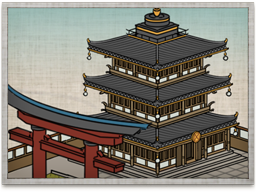Difference between revisions of "Temple Complex (TWS2)"
m |
|||
| (4 intermediate revisions by the same user not shown) | |||
| Line 1: | Line 1: | ||
{{TWS2 Building|image=[[Image:Temple Complex S2TW.png]] | {{TWS2 Building|image=[[Image:Temple Complex S2TW.png]] | ||
|Chain=Buddhist Type | |Chain=Buddhist Type | ||
| − | |Requires='''Buildings''':<li>[[Monastery (TWS2)|Monastery]]</li>'''Arts''':<li>[[Scholarship]]</li>'''Resources''':<li>Incense</li> | + | |Requires='''Religion''':<li>Shinto-Buddhism</li> |
| + | '''Buildings''':<li>[[Monastery (TWS2)|Monastery]]</li> | ||
| + | '''Arts''':<li>[[Scholarship]]</li> | ||
| + | '''Resources''':<li>Incense</li> | ||
|Enables='''Buildings''':<li>[[Famous Temple (TWS2)|Famous Temple]]</li> | |Enables='''Buildings''':<li>[[Famous Temple (TWS2)|Famous Temple]]</li> | ||
| + | '''Units''':<li>[[Naginata Warrior Monks (TWS2 Unit)|Naginata Warrior Monks]]</li> | ||
| + | <li>[[Bow Warrior Monks (TWS2 Unit)|Bow Warrior Monks]]</li> | ||
| + | <li>[[Matchlock Warrior Monks (TWS2 Unit)|Matchlock Warrior Monks]]</li> | ||
| + | <li>[[Warrior Nuns (TWS2 Unit)|Warrior Nuns]]</li> | ||
| + | <li>[[Uesugi Warrior Monks (TWS2 Unit)|Uesugi Warrior Monks]]</li> | ||
| + | <li>[[Uesugi Bow Warrior Monks (TWS2 Unit)|Uesugi Bow Warrior Monks]]</li> | ||
| + | <li>[[Uesugi Marathon Monks (TWS2 Unit)|Uesugi Marathon Monks]]</li> | ||
| + | <li>[[Chosokabe Bow Warrior Monks (TWS2 Unit)|Chosokabe Bow Warrior Monks]]</li> | ||
|Spawned Defence Forces=- | |Spawned Defence Forces=- | ||
| − | |Basic Building Statistics=<li>+2 happiness for the Buddhist population </li> | + | |Basic Building Statistics=<li>Cost: 4500</li> |
| − | <li>Spreads Buddhism to neighbouring provinces (+ | + | <li>+2 happiness for the Buddhist population</li> |
| + | <li>Spreads Buddhism to neighbouring provinces (+3 religious zeal)</li> | ||
<li>Converts the populace to Buddhism (+4 religious zeal)</li> | <li>Converts the populace to Buddhism (+4 religious zeal)</li> | ||
<li>Enables recruitment of Rank 1 monks</li> | <li>Enables recruitment of Rank 1 monks</li> | ||
|Clan Effects=<li>Improves the rate at which chi arts are mastered: +10%</li> | |Clan Effects=<li>Improves the rate at which chi arts are mastered: +10%</li> | ||
| − | <li>Each Buddhist chain enables you to sustain one additional monk</li>}} | + | <li>Each Buddhist chain enables you to sustain one additional monk (Maximum: 5)</li>}} |
==Description== | ==Description== | ||
| − | + | '''The whole world lies within the garden for one who cares to see it.''' | |
| − | + | The beautiful gardens and tranquil surroundings of a temple complex bring peace and harmony to all who dwell there. No one in the province can fail to be moved by the spirituality of the place. Each building in the complex is carefully constructed to meet the religious needs of its occupants. In turn, this helps to increase the happiness of all Buddhists in the province and allows the recruitment of new units. | |
| − | + | Temples played an important role in Japan, as many great advances happened within their walls and many great people sheltered in them, away from the dangers and troubles of daily life. Some great men chose temples as their final resting places: the remains of Oda Nobunaga, the unifier of Japan, rest at Daitokuji, in the Murasakino section of Kyoto. A little earlier, this temple had been home to Sen no Rikyu (1522-1591), the man who is credited with the development of the tea ceremony. He built tearooms and gardens within Daitokuji to continue the cultural development of the temple, and encouraged his brothers to devote themselves to mastery of the tea ceremony. It came to embody the key principles of Zen, and became popular with the mighty shoguns of Japan. A man who could perform the tea ceremony was a formidable individual indeed. | |
[[Category:TWS2 Building]] | [[Category:TWS2 Building]] | ||
Latest revision as of 02:34, 20 January 2013
| Temple Complex (TWS2) | |
|---|---|
 | |
| Chain | Buddhist Type |
| Requires | Religion: |
| Enables | Buildings: |
| Spawned Defence Forces | - |
| Basic Building Statistics | |
| Clan Effects | |
| See main article; FotS Buildings | |
Description
The whole world lies within the garden for one who cares to see it.
The beautiful gardens and tranquil surroundings of a temple complex bring peace and harmony to all who dwell there. No one in the province can fail to be moved by the spirituality of the place. Each building in the complex is carefully constructed to meet the religious needs of its occupants. In turn, this helps to increase the happiness of all Buddhists in the province and allows the recruitment of new units.
Temples played an important role in Japan, as many great advances happened within their walls and many great people sheltered in them, away from the dangers and troubles of daily life. Some great men chose temples as their final resting places: the remains of Oda Nobunaga, the unifier of Japan, rest at Daitokuji, in the Murasakino section of Kyoto. A little earlier, this temple had been home to Sen no Rikyu (1522-1591), the man who is credited with the development of the tea ceremony. He built tearooms and gardens within Daitokuji to continue the cultural development of the temple, and encouraged his brothers to devote themselves to mastery of the tea ceremony. It came to embody the key principles of Zen, and became popular with the mighty shoguns of Japan. A man who could perform the tea ceremony was a formidable individual indeed.